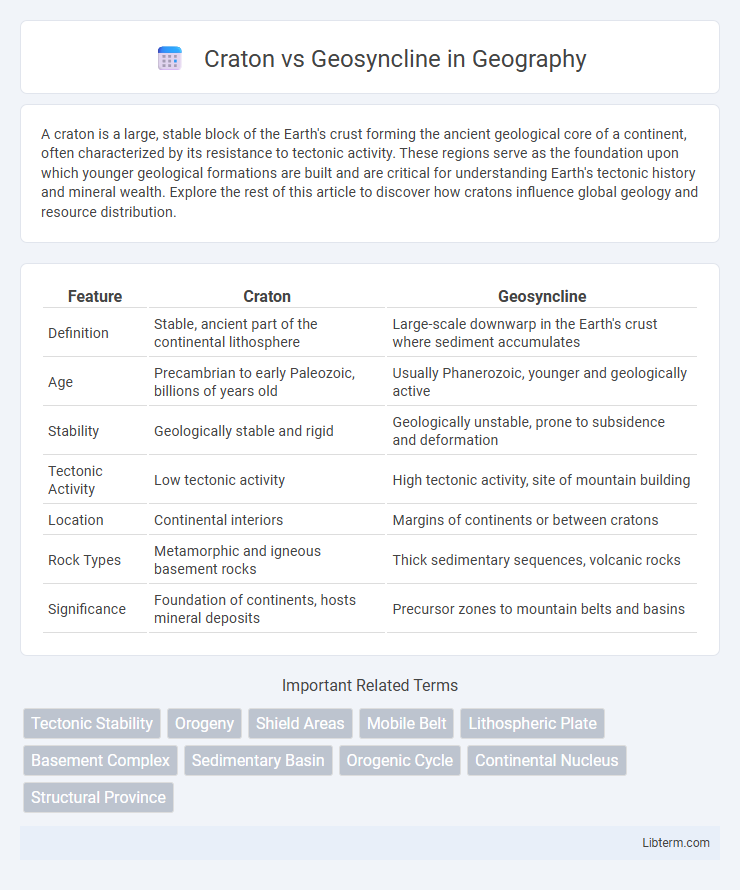A craton is a large, stable block of the Earth's crust forming the ancient geological core of a continent, often characterized by its resistance to tectonic activity. These regions serve as the foundation upon which younger geological formations are built and are critical for understanding Earth's tectonic history and mineral wealth. Explore the rest of this article to discover how cratons influence global geology and resource distribution.
Table of Comparison
| Feature | Craton | Geosyncline |
|---|---|---|
| Definition | Stable, ancient part of the continental lithosphere | Large-scale downwarp in the Earth's crust where sediment accumulates |
| Age | Precambrian to early Paleozoic, billions of years old | Usually Phanerozoic, younger and geologically active |
| Stability | Geologically stable and rigid | Geologically unstable, prone to subsidence and deformation |
| Tectonic Activity | Low tectonic activity | High tectonic activity, site of mountain building |
| Location | Continental interiors | Margins of continents or between cratons |
| Rock Types | Metamorphic and igneous basement rocks | Thick sedimentary sequences, volcanic rocks |
| Significance | Foundation of continents, hosts mineral deposits | Precursor zones to mountain belts and basins |
Introduction to Cratons and Geosynclines
Cratons are stable, ancient parts of the continental lithosphere, often composed of Precambrian rocks that have remained tectonically inactive for billions of years. Geosynclines represent large-scale, elongated downwarps in the Earth's crust filled with thick sedimentary and volcanic layers, typically sites of future orogenic activity. Understanding the contrasting nature of cratons and geosynclines is essential for interpreting continental formation and mountain-building processes.
Defining Cratons: Characteristics and Formation
Cratons are ancient, stable parts of the continental lithosphere characterized by thick, buoyant roots extending deep into the mantle, often exceeding 200 kilometers in thickness. These geological entities formed during the Archean and Proterozoic eons through processes such as continental accretion, magmatic activity, and subsequent tectonic stabilization. Their defining features include low seismic activity, resistance to deformation, and preservation of primordial mineral deposits, contrasting sharply with the sedimentary troughs typical of geosynclines.
Understanding Geosynclines: Structure and Evolution
Geosynclines are extensive, elongated troughs in the Earth's crust that accumulate thick sedimentary layers through subsidence and sedimentation over geological time, playing a crucial role in orogenic processes. Their structure is characterized by deep basins that facilitate the deposition of sediments, which later undergo deformation, folding, and metamorphism during mountain-building events. Understanding geosynclines involves analyzing their sedimentary sequences and tectonic evolution to distinguish them from stable cratons, which are ancient, rigid parts of the continental lithosphere with minimal tectonic activity.
Geological Features: Craton vs Geosyncline
Cratons are stable, ancient parts of the continental lithosphere characterized by thick, rigid crust and low seismic activity, often forming the cores of continents. Geosynclines are large-scale, linear troughs in the Earth's crust that accumulate thick sedimentary sequences and experience significant tectonic deformation and subsidence over geological time. While cratons exhibit stability and resistance to deformation, geosynclines are dynamic regions associated with mountain-building processes and sedimentary basin formation.
Tectonic Stability: Comparing Cratons and Geosynclines
Cratons exhibit high tectonic stability due to their ancient, thick lithospheric roots that resist deformation, playing a crucial role in continental stability and preservation over geological time. In contrast, geosynclines are tectonically active regions characterized by significant sediment accumulation and frequent deformation, serving as zones of crustal subsidence and mountain-building processes. The juxtaposition of stable cratonic interiors versus dynamic geosynclinal belts underlines their contrasting roles in Earth's tectonic framework.
Role in Plate Tectonics and Earth's History
Cratons are stable, ancient continental cores that serve as the foundational platforms for continental growth and preservation throughout Earth's history. Geosynclines represent elongated, subsiding troughs in the Earth's crust where sediment accumulation and deformation occur, often leading to mountain-building processes at convergent plate boundaries. The interplay between cratons and geosynclines drives plate tectonic dynamics by facilitating continental stability and orogenic activity during supercontinent assembly and breakup.
Economic Importance: Mineral Resources in Cratons and Geosynclines
Cratons, with their stable, ancient lithospheric roots, host significant deposits of valuable minerals such as diamonds, gold, and base metals, making them prime targets for mining activities. Geosynclines, characterized by intense sedimentation and tectonic activity, are rich in hydrocarbon resources, including oil and natural gas, formed from organic material trapped in sedimentary basins. Both cratons and geosynclines contribute substantially to global mineral resource extraction, but their economic importance varies according to the types of deposits they harbor.
Classic Examples from Around the World
The Canadian Shield exemplifies a classic craton, showcasing ancient, stable Precambrian rock formations resistant to tectonic activity. The Appalachian Basin in the eastern United States serves as a prominent geosyncline example, characterized by sedimentary layers deposited in a subsiding trough before mountain-building events. These contrasting structures highlight cratonic stability versus the dynamic sediment accumulation and deformation typical of geosynclines.
Current Research and Scientific Perspectives
Current research reveals that cratons, the stable interior portions of continental plates, exhibit remarkable longevity and rigidity due to their thick lithospheric roots and depleted mantle composition. Geosynclines, historically viewed as large-scale sedimentary basins, are now understood through plate tectonic theory as regions undergoing subsidence and intense deformation linked to convergent margins and orogenic processes. Advances in geophysical imaging and isotopic dating continue to refine distinctions between ancient cratonic shields and actively deforming geosynclinal regions, highlighting their contrasting roles in continental evolution.
Conclusion: Key Differences and Geological Significance
Cratons are stable, ancient continental cores characterized by thick, rigid lithosphere, whereas geosynclines represent mobile, sediment-filled troughs that undergo extensive deformation and mountain building. The geological significance of cratons lies in their role as foundational platforms preserving Earth's early crust, while geosynclines are crucial for understanding active tectonic processes and orogeny. Recognizing these distinctions aids in reconstructing Earth's tectonic evolution and resource distribution.
Craton Infographic

 libterm.com
libterm.com